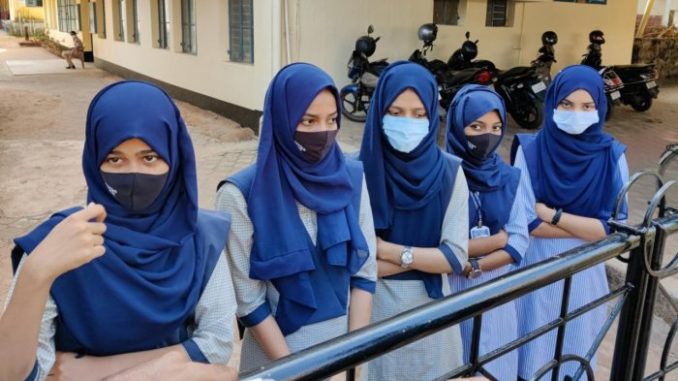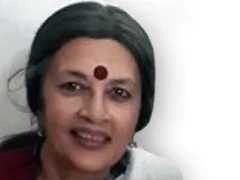

“The confrontations being organized, and divisions created among the youth at a time when lakhs of students have suffered a loss of education because of online learning which they could not access, is nothing short of criminal. What is being played out is the open and blatant promotion of the Hindutva agenda extended to educational institutions. The Corona pandemic is being replaced by the communal pandemic, a virus created in the laboratory of the Hindutva forces, leading to a lockdown of educational institutions, ruining the lives of young people.”
There is nothing controversial about Muslim girls wanting to wear a headscarf, referred to (incorrectly) as a “hijab”. But describing the happenings in BJP-ruled Karnataka as the ” hijab controversy” is misleading. It is nothing of the kind. It is an outright assault on the right to education of young Muslim women, guaranteed to them by the law and the Constitution of India. It is significant that even the National Human Rights Commission, thought to be pro-government under its new chief, issued notice to the district authorities in Udipi on January 27after it received a complaint stating ” Facts of the case are disturbing. The allegations made in the complaint are serious in nature involving ‘Right to Education’. The case therefore involves grave violation of human rights of the victim students.”
It is thus very disappointing that the single bench of the Karnataka High Court did not grant an interim stay against the Karnataka government’ s wholly unwarranted and misconceived order of February 5 which has jeopardized the future of hundreds of young Muslim women studying for their final Class 12 exams scheduled in just two months. The order wrongly invokes Section 133 (2) of the Karnataka Education Act, 1983, to state that students have to wear the dress chosen by the college Development Committee or the Appellate Committee of the Administrative Board of Pre-University Colleges, which come under the Pre-University Education Department. In the event of the Administrative Committee not selecting a uniform, “clothes which disturb equality, integrity and public law and order should not be worn. ” The use of this particular section 133(2) is itself questionable since it permits direct intervention by the state government in matters pertaining to ” development of education.” Uniforms surely do not fit into this category.
The intent of this dubious phrasing is clear enough. In Karnataka, College Development Committees are headed by the elected MLA of the area in which the college is located. The PU college in Udipi district, where the issue first started, is headed by the BJP MLA on whose watch the decision was taken to impose the ban on entering campuses for girls wearing headscarves, even though the college has no such rules against the wearing of a headscarf. The Bajrang Dal Udipi district secretary Surender Koteshwar warned that “If the college allows students to wear hijab on campus, they would make all Hindu students put on saffron shawls inside the campus.”
He put this plan into action with government patronage. First, the government, through its network of non-state actors like him and the Bajrang Dal mobilized aggressive young men wearing saffron scarves as a counter, then it allowed them to march to colleges where Muslim girls were being shut out at the gates, its police forces standing by as spectators as girls were heckled and harassed, and then, in the name of being “even-handed”, it issued an order which in effect held that the headscarf could cause a public law and order problem and was therefore prohibited, whether the college had such a rule or not. In fact, another college, the Bhandarkars Arts and Science Degree College, which is also in the Udipi district, had permitted girls to wear headscarves and specified that the coloring should be the same as the dupatta. But today, in spite of this rule, girls are being kept out of this college. Is this not blatantly unfair? This kind of targeting of Muslim girls leads to a counter-response among the community, and wearing a headscarf becomes a symbol of protest even for those who never wore one. This is also what we see developing in Karnataka. In such a situation, the grounds are laid for extremist Muslim organizations who are not in support of women’s freedom to promote their fundamentalist ideology.
It is being presented as if the very concept of a uniform in educational institutions is being opposed by the girls. The Karnataka Education Minister BC Nagesh stated, ” I have appealed to all these students to honor the uniform prescribed by the government. I am also making it clear that those who want to defy the government’s school uniform regulations cannot enter their schools and attend classes. ” Muslim girls are wearing the prescribed uniform. They are, in addition, covering their heads with a headscarf. They are not replacing their uniform with a burkha. They are not using a veil to cover their face. When boys of the Sikh religion wear turbans. are they defying the government’s orders on uniforms? Are there any rules anywhere in India which prevent a Sikh boy or girl from covering their head? Why should there be double standards? No one is against uniforms in educational institutions. There is no defiance of uniform regulations in the case of a Muslim girl wearing a headscarf.
The contention that this could be a law and order issue is absurd. All these years, it has never been a public law and order problem anywhere in Karnataka or indeed, India. In neighboring Kerala, Muslim students may if they choose, wear a headscarf. Many choose not to. There is no compulsion either way. There has been no law and order problem created by girls wearing headscarves in Kerala. It is a state which has the highest literacy rate among Muslim women and also the highest enrolment of Muslim girls in higher secondary schools. The reference to public order in the Karnataka government directive is deliberate. Article 25 of the Constitution states “(1) Subject to public order, morality and health and to the other provisions of this Part, all persons are equally entitled to freedom of conscience and the right freely to profess, practice and propagate religion.” By bringing in the issue of public order, the government is building a case that its stand is protected by the Constitution since in this case ” the right to profess, practice and propagate religion” is leading to a problem of public order.
There is a specific case dealt by the Kerala High Court (Amnah Bint Basheer vs CBSE 2016) which has held that wearing a headscarf and long sleeves for a Muslim woman is “an essential religious practice” which has the protection of Article 25. The case concerned a Muslim female candidate who was offended by the CBSE dress code stipulating short sleeves for women and no head covering on the grounds that it violated her fundamental rights under Section 25. The court upheld her objection since the CBSE directive was to prevent the smuggling in of materials to cheat and was not connected to public order or morality. However, the judgement also instructed the candidate to subject herself to physical inspection by CBSE-appointed authorities. Thus, the integrity of the examination process was protected, as also her fundamental right. Earlier as well in 2015 in another case (Nadia Raheem vs CBSE), the court had upheld the petition of two Muslim female candidates to wear a head scarf and long sleeves on grounds of religious belief. The court noted that in a country with many religions and diverse customs, it cannot be insisted that a particular dress code be followed failing which a student would be prohibited from sitting for the examinations. In this case too, the court directed the candidate to subject herself to physical inspection to address CBSE’s concerns. It is to circumvent the implications of these judgements that the Karnataka Government has deliberately created a public law and order problem as a fait accompli before the court hearings.
The focus should surely be on extending the right to education to more and more children. Girl students suffered disproportionately during these two years of online classes. According to the Right to Education Forum. ten million girls in India could drop out of secondary school due to the COVID-19 pandemic. A Karnataka survey, conducted by the Department of Rural Development and Panchayat Raj, whose findings were submitted to the state’s High Court in July 2021, found that 1.59 lakh children in rural Karnataka did not go to school. Yet this government is forcibly preventing girls from attending school, pushing a narrow agenda. It would seem that these Muslim girls are to be excluded as betis – daughters- in the” Beti Bachao, Beti Padao” slogan of the government.
It is a tragedy to see young people’s emotions being manipulated so cynically by these forces. The confrontations being organized, and divisions created among the youth at a time when lakhs of students have suffered a loss of education because of online learning which they could not access, is nothing short of criminal. What is being played out is the open and blatant promotion of the Hindutva agenda extended to educational institutions. The Corona pandemic is being replaced by the communal pandemic, a virus created in the laboratory of the Hindutva forces, leading to a lockdown of educational institutions, ruining the lives of young people.
(The author is an Indian politician)
(Source: Wire)





Be the first to comment